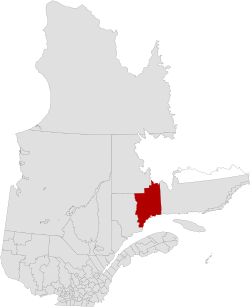
La Haute-Gaspésie is a regional county municipality in the Gaspésie–Îles-de-la-Madeleine region of eastern Quebec, Canada, on the Gaspé peninsula. The regional county municipality seat is in Sainte-Anne-des-Monts.

Deux-Montagnes is a regional county municipality in the Laurentides region of Quebec, Canada. It is located immediately north of Laval on the north shore of the Rivière des Mille-Îles and on the north shore of the Lake of Two Mountains. Its seat and largest city is Saint-Eustache.

La Rivière-du-Nord is a regional county municipality in the Laurentides region of Quebec, Canada. The seat is in Saint-Jérôme. It is named for the river that runs through it, the Rivière du Nord.

Les Jardins-de-Napierville is a regional county municipality (RCM) in southwestern Quebec, Canada, in the Montérégie region. Founded on January 1, 1982. Its seat is Napierville.

Les Moulins is a regional county municipality in the Lanaudière region of Quebec, Canada.

La Matanie is a regional county municipality, located in the Bas-Saint-Laurent region of Quebec, in Canada. From January 1, 1982, to March 9, 2013, it was known as Matane.

Minganie is a regional county municipality on the north shore of the Gulf of St. Lawrence, in Côte-Nord region, Quebec, Canada, its territory includes Anticosti Island.

Rivière-du-Loup is a regional county municipality in the Bas-Saint-Laurent region of Quebec, Canada. Its most important city is Rivière-du-Loup, which contains more than half of the population.

Thérèse-De Blainville is a regional county municipality in the Laurentides region of Quebec, Canada. It is located immediately north of Laval on the north shore of the Rivière des Mille-Îles.

Caniapiscau is a regional county municipality in the Côte-Nord region of Quebec, Canada. The seat is Fermont.

Les Chenaux is a regional county municipality in central Quebec, Canada, in the Mauricie region. The seat is in Saint-Luc-de-Vincennes. It is located adjacent on the east of Trois-Rivières on the Saint Lawrence River. It has a land area of 872.04 square kilometres (336.70 sq mi) and a population of 17,865 inhabitants in the Canada 2011 Census. Its largest community is the parish of Notre-Dame-du-Mont-Carmel.

Fermont is a mining city in Côte-Nord region, Quebec, Canada, near the Quebec-Labrador border about 23 kilometres (14 mi) from Labrador City on Route 389, which connects to the Trans-Labrador Highway. It is the seat of the Regional County Municipality of Caniapiscau.

Saint-Clément is a municipality in the Canadian province of Quebec, located in Les Basques Regional County Municipality in the Bas-Saint-Laurent region.

L'Ange-Gardien is a municipality in the Capitale-Nationale region of Quebec, Canada. It is part of La Côte-de-Beaupré Regional County Municipality.

Notre-Dame-des-Sept-Douleurs is an island municipality in the Bas-Saint-Laurent region of Quebec, Canada, part of the Rivière-du-Loup Regional County Municipality. It is located on and contiguous with Île Verte in the Estuary of St. Lawrence, about 20 kilometres (12 mi) north-east of Rivière-du-Loup. The name Île Verte was given in 1621 by Samuel de Champlain written "Isle Verte".

Rivière-au-Tonnerre, municipality located on the North shore of the Gulf of St. Lawrence, in Côte-Nord region, Minganie Regional County Municipality, in the province of Quebec, Canada.
Sept-Rivières—Caniapiscau is a census division (CD) of Quebec, with geographical code 97. It consists of the regional county municipalities of Sept-Rivières and Caniapiscau.
Rivière-Nipissis is an unorganized territory in the Côte-Nord region of Quebec, Canada, part of the Sept-Rivières Regional County Municipality.

Le Golfe-du-Saint-Laurent is a regional county municipality in the Côte-Nord region of far-eastern Quebec, Canada. It includes all communities along the Gulf of Saint Lawrence between the Natashquan River and the Newfoundland and Labrador border.

















